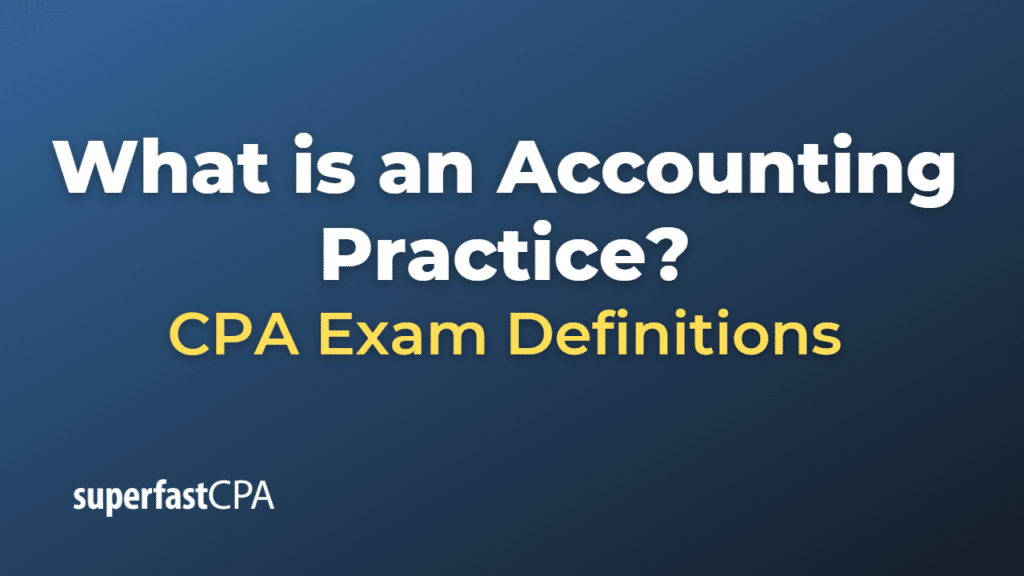Accounting Practice
An accounting practice refers to the routine methods, procedures, and guidelines that accountants and bookkeepers follow when recording, analyzing, and reporting a company’s financial transactions. Accounting practices are grounded in established accounting principles and standards, such as Generally Accepted Accounting Principles (GAAP) in the United States or International Financial Reporting Standards (IFRS) in many other countries. These practices help to ensure that financial statements are prepared in a consistent, comparable, and reliable manner, meeting the needs of various stakeholders, such as investors, creditors, regulators, and management.
Accounting practices typically cover a wide range of areas, including:
- Recording transactions: Accountants use a double-entry bookkeeping system to record financial transactions, ensuring that each transaction is entered as both a debit and a credit in the appropriate accounts. This practice helps to maintain an accurate and balanced record of a company’s financial activities.
- Classifying transactions: Financial transactions are categorized into different accounts based on their nature, such as assets, liabilities, equity, revenue, or expenses. This practice facilitates the systematic organization and analysis of financial information.
- Adjusting entries: At the end of each accounting period, accountants make adjusting entries to update account balances for items such as accrued expenses, prepaid expenses, depreciation, and unearned revenue. This practice ensures that the financial statements accurately reflect the company’s financial position and performance at the end of the period.
- Preparing financial statements: Accountants prepare financial statements, such as the income statement, balance sheet, and cash flow statement, to summarize and communicate a company’s financial performance and position. These statements are prepared in accordance with applicable accounting standards and guidelines, ensuring that they are consistent, comparable, and reliable.
- Reconciling accounts: Accountants periodically reconcile various accounts, such as bank accounts, accounts receivable, and accounts payable, to ensure that the balances recorded in the accounting system are accurate and complete. This practice helps to identify and resolve any discrepancies or errors in the financial records.
- Internal controls: Companies establish internal controls to safeguard their assets, ensure the accuracy and reliability of their financial records, and promote efficient and effective operations. These controls may include segregation of duties, authorization and approval procedures, and regular reviews and audits of financial records.
Accounting practices are essential for maintaining accurate, reliable, and transparent financial records that meet the needs of various stakeholders and comply with applicable regulations and standards. By following established accounting practices, companies can effectively manage their financial performance, make informed management decisions, and build trust with investors, creditors, and other stakeholders.
Example of an Accounting Practice
Let’s consider a hypothetical example of a small retail clothing store, “FashionHub,” to illustrate some common accounting practices in action.
- Recording transactions: FashionHub uses a double-entry bookkeeping system to record its financial transactions. For example, when the store purchases inventory from a supplier for $5,000 on credit, the following journal entry is made:
Debit: Inventory (Asset) – $5,000 Credit: Accounts Payable (Liability) – $5,000
This entry records the increase in inventory (an asset) and the corresponding increase in accounts payable (a liability) as the store owes the supplier for the inventory.
- Classifying transactions: FashionHub categorizes its financial transactions into appropriate accounts based on their nature. For example, when the store sells clothing items for $2,000 cash, the following journal entry is made:
Debit: Cash (Asset) – $2,000 Credit: Sales Revenue (Revenue) – $2,000
This entry records the increase in cash (an asset) and the corresponding increase in sales revenue (revenue) from the sale of clothing items.
- Adjusting entries: At the end of the month, FashionHub’s accountant makes adjusting entries to update account balances. For example, if the store has accrued $1,000 in wages for employees that have not yet been paid, the following adjusting entry is made:
Debit: Wages Expense (Expense) – $1,000 Credit: Accrued Wages (Liability) – $1,000
This entry records the wages expense for the period and the corresponding liability for the unpaid wages.
- Preparing financial statements: FashionHub’s accountant prepares monthly financial statements, including an income statement, balance sheet, and cash flow statement. These statements provide a summary of the store’s financial performance and position and are prepared according to applicable accounting standards (e.g., GAAP or IFRS).
- Reconciling accounts: Each month, FashionHub’s accountant reconciles the store’s bank account by comparing the bank statement with the cash account in the accounting system. This process helps identify any discrepancies or errors in the financial records, such as missed transactions, duplicate entries, or incorrect amounts.
- Internal controls: FashionHub has implemented internal controls to safeguard its assets and ensure the accuracy and reliability of its financial records. For example, the store has segregation of duties, where different employees are responsible for handling cash, recording transactions, and reconciling accounts. Additionally, the store owner regularly reviews financial records and approves significant transactions, such as large inventory purchases.
These examples demonstrate how accounting practices are applied in a real-world business context, helping to ensure that financial records are accurate, reliable, and transparent.













